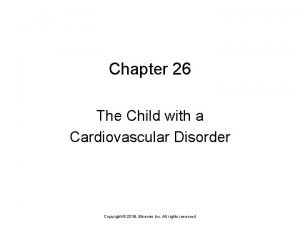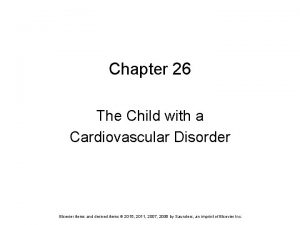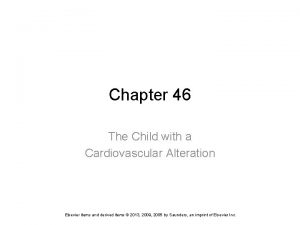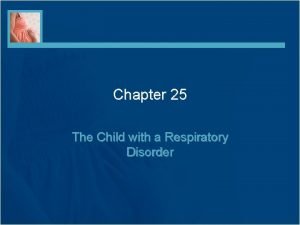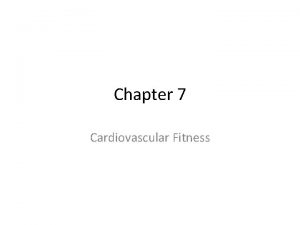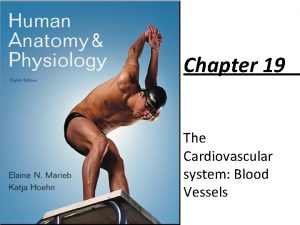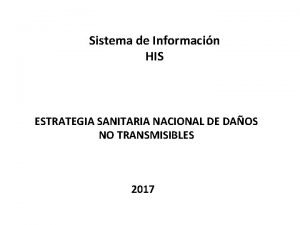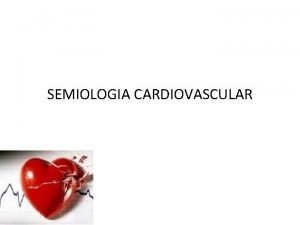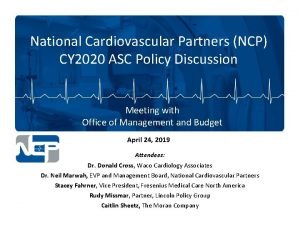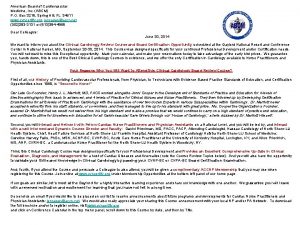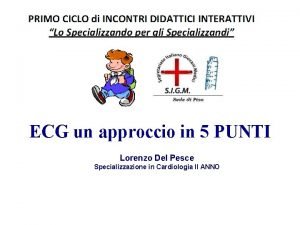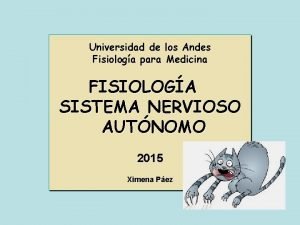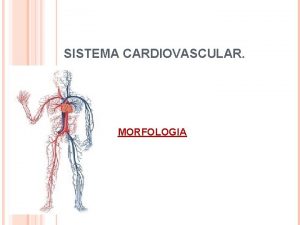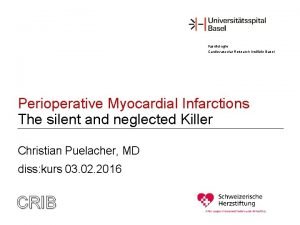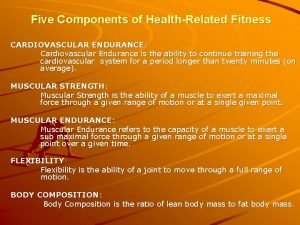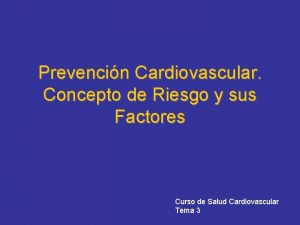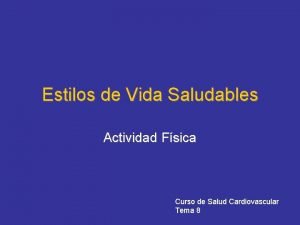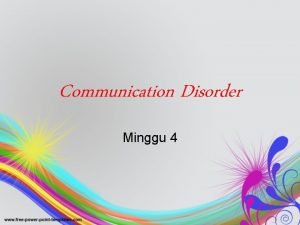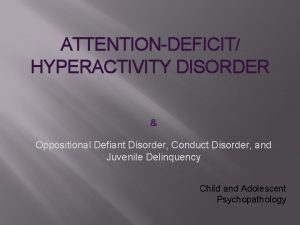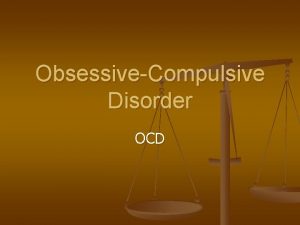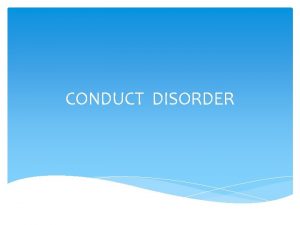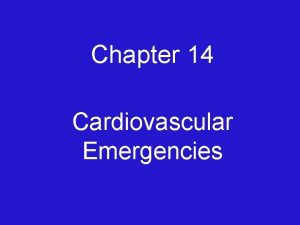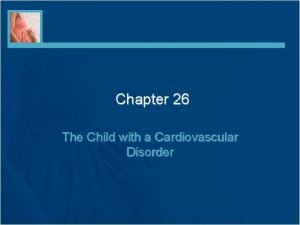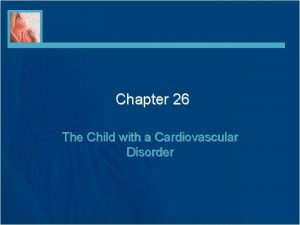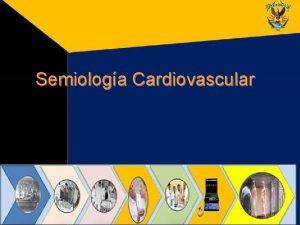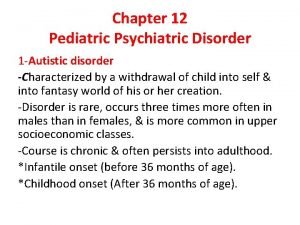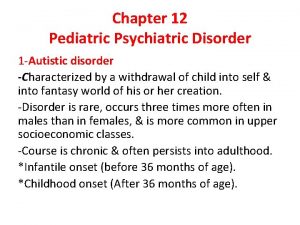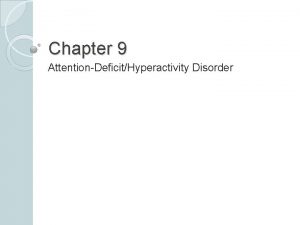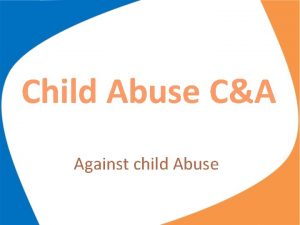Chapter 26 The Child with a Cardiovascular Disorder










































- Slides: 42

Chapter 26 The Child with a Cardiovascular Disorder Copyright © 2019, Elsevier Inc. All rights reserved.

Signs Related to Suspected Cardiac Pathology Failure to thrive or poor weight gain Cyanosis, pallor Visually observed pulsations in the neck veins Tachypnea, dyspnea Irregular pulse rate Clubbing of fingers Fatigue during feeding or activity Excessive perspiration, especially over forehead Copyright © 2019, Elsevier Inc. All rights reserved. 2

Congenital Heart Disease (1 of 5) The most common type of birth defect Occurs in approximately 8 of 1000 births 50% of these infants show signs or symptoms within the first year of life Can be caused by genetic, maternal, or environmental factors Not a problem for the fetus because of the fetalmaternal circulation Ø At birth, the infant’s circulatory system must take over and provide the child’s oxygen needs. Ø Copyright © 2019, Elsevier Inc. All rights reserved. 3

Congenital Heart Disease (2 of 5) Of the congenital anomalies, heart defects are the principal cause of death during the first year of life. Diagnostic studies vary from noninvasive, such as an electrocardiogram, to invasive, such as angiogram. After diagnosis is confirmed, most cardiac defects require surgical intervention. Copyright © 2019, Elsevier Inc. All rights reserved. 4

Congenital Heart Disease (3 of 5) Classification Two categories Cyanotic Ø Acyanotic Ø Blood always flows from area of high pressure to an area of low pressure, and it also takes the path of least resistance. Copyright © 2019, Elsevier Inc. All rights reserved. 5

Congenital Heart Disease (4 of 5) Physiologically, defects can be organized into lesions that Increase pulmonary blood flow Ø Obstruct blood flow Ø Decrease pulmonary blood flow Ø A shunt refers to the flow of blood through an abnormal opening between two vessels of the heart. Copyright © 2019, Elsevier Inc. All rights reserved. 6

Defects with increased pulmonary blood flow Ventricular septal defect Atrial septal defect Patent ductus arteriosus Normal fetal circulatory conduit between the pulmonary artery and aorta fails to close Ø Murmur Ø Wide pulse pressure Ø Bounding pulses Ø Heart failure Ø Copyright © 2019, Elsevier Inc. All rights reserved. 7

Copyright © 2019, Elsevier Inc. All rights reserved. 8

Congenital Heart Disease (5 of 5) Defects that increase pulmonary blood flow Ø Blood returns to the right ventricle and recirculates through the lungs before exiting the left ventricle through the aorta. Some defects that increase pulmonary flow are Atrial septal defect Ø Ventricular septal defect and patent ductus arteriosus Ø The oxygenated blood recirculates to the lungs, and cyanosis is rare. Copyright © 2019, Elsevier Inc. All rights reserved. 9

Atrial septal defect An abnormal opening between the right and left atria Most patients are asymptomatic Copyright © 2019, Elsevier Inc. All rights reserved. 10

Ventricular septal defect Most common heart anomaly Abnormal opening between the right and left ventricles More serious than ASD- the higher pressure in the left ventricle forces blood back into the right ventricle Leads to decreased cardiac output Produces a loud, harsh murmur Copyright © 2019, Elsevier Inc. All rights reserved. 11

Copyright © 2019, Elsevier Inc. All rights reserved. 12

Restrictive Defects Restriction usually from some form of stenosis of the vessel Ø Coarctation of the aorta • Narrowing or constriction of the aortic arch or of the descending aorta • Hemodynamically, increased pressure proximal to the defect and decreased pressure distally • Blood pressure will be higher in the arms than in the legs Copyright © 2019, Elsevier Inc. All rights reserved. 13

Copyright © 2019, Elsevier Inc. All rights reserved. 14

Copyright © 2019, Elsevier Inc. All rights reserved. 15

Defects that Decrease Pulmonary Blood Flow Occurs when a congenital heart anomaly allows blood that has not passed through the lungs (unoxygenated blood) to enter the aorta and general circulation Cyanosis caused by the presence of unoxygenated blood in the circulation is a characteristic feature of this type of congenital heart anomaly Copyright © 2019, Elsevier Inc. All rights reserved. 16

Tetralogy of Fallot Four defects Stenosis or narrowing of the pulmonary artery • Decreases blood flow to the lungs Ø Hypertrophy of the right ventricle • Enlarges because it must work harder to pump blood Ø through the narrow pulmonary artery Ø Dextroposition of the aorta • The aorta is displaced to the right and blood from both ventricles enters it Ø Ventral septal defect (VSD) Copyright © 2019, Elsevier Inc. All rights reserved. 17

Tetralogy of Fallot Child will develop CHF as a result of narrowing of the pulmonary artery Will also experience paroxysmal hypercyanotic episodes (“tet spells”) Position infant with legs flexed toward abdomen Toddler will instinctively squat Child will develop polycythemia as a result of hypoxia Also clubbed fingers Copyright © 2019, Elsevier Inc. All rights reserved. 18

Copyright © 2019, Elsevier Inc. All rights reserved. 19

Paroxysmal Hypercyanotic Episodes Known as tet spells Occur during the first 2 years of life Spontaneous cyanosis, respiratory distress, weakness, and syncope occur. They can last up to a few hours and are followed by lethargy and sleep. Place child in knee-chest position when tet spell occurs. Copyright © 2019, Elsevier Inc. All rights reserved. 20

Defects that Cause Mixed Pathology (1 of 2) Hypoplastic left heart syndrome Underdevelopment of the left side of the heart Ø Usually results in an absent or nonfunctional left ventricle and hypoplasia of the ascending aorta Ø Can be diagnosed before birth, and infant is placed on a heart transplant list early Ø Copyright © 2019, Elsevier Inc. All rights reserved. 21

Defects that Cause Mixed Pathology (2 of 2) Hypoplastic left heart syndrome (cont. ) Initial survival depends on a patent foramen ovale and ductus arteriosus to provide a pathway for oxygenated blood to the general body system. Ø Symptoms include • A grayish-blue color of the skin and mucous membranes • Signs of CHF • Dyspnea • Weak pulses • Cardiac murmur Ø Copyright © 2019, Elsevier Inc. All rights reserved. 22

General Treatment and Nursing Care Assorted medical and surgical treatments are currently available. After the procedure, the nursing care involves Monitoring vital signs Ø Observing for thrombosis formation Ø Performing neurovascular checks of the limb Ø Providing emotional support to child and family Ø Copyright © 2019, Elsevier Inc. All rights reserved. 23

Parent Teaching on General Treatment and Nursing Care Instruct parents that children with congenital heart disease should avoid competitive sports because the pressure for a team win can interfere with the child’s need to stop activity if specific symptoms arise. Nutritional guidance aimed at preventing anemia and promoting optimal growth and development Vacations to high altitudes or very cold environments may cause adverse responses in a child who is already hypoxic or has cardiac problems. Copyright © 2019, Elsevier Inc. All rights reserved. 24

Acquired Heart Disease Occurs after birth May be a complication of a congenital heart disease or a response to respiratory infection, sepsis, hypertension, or severe anemia Heart failure is a decrease in cardiac output necessary to meet the metabolic needs of the body. Copyright © 2019, Elsevier Inc. All rights reserved. 25

Congestive Heart Failure (CHF) Manifestations depend on the side of the heart affected Ø Right side of the heart moves unoxygenated blood to the pulmonary circulation. • A failure results in the backup of blood in the systemic venous system. Ø Left side of heart moves oxygenated blood from the pulmonary circulation to the systemic circulation. • Failure results in backup into the lungs. Copyright © 2019, Elsevier Inc. All rights reserved. 26

CHF Goals of Treatment Goals Reduce the work of the heart. Ø Improve respiration. Ø Maintain proper nutrition. Ø Prevent infection. Ø Reduce the anxiety of the patient. Ø Support and instruct the parents. Ø Copyright © 2019, Elsevier Inc. All rights reserved. 27

CHF and Nursing Care Organize care so that infant is not unnecessarily disturbed. Feed early if crying and late if asleep. Feedings are small and frequent. Oxygen is administered to relieve dyspnea. Medications are given as prescribed after dosages are checked for safety. Accurate recording of intake and output. Copyright © 2019, Elsevier Inc. All rights reserved. 28

Medications Digoxin (Lanoxin) Monitor for toxicity (nausea, vomiting, anorexia) Ø Monitor heart rate; hold if < 60 Ø ACE inhibitors (Captopril, Ramipril) Ø Observe for hypotension, cough, renal dysfunction Diuretics-furosemide (Lasix) or chlorothiazide Monitor electrolytes, especially potassium Ø Hypokalemia is a common side effect Ø Copyright © 2019, Elsevier Inc. All rights reserved. 29

Nursing care- CHF Monitor strict I&O Assess frequently Educate and support parents Ensure knowledge of CPR (nursing staff and parents) and PALS (nursing staff) Suitable diet with adequate fluids Copyright © 2019, Elsevier Inc. All rights reserved. 30

Rheumatic Fever (RF) Systemic disease involving the joints, heart, central nervous system, skin, and subcutaneous tissues Ø Common feature is destruction of connective tissue. Ø Scars mitral valve in the heart Peak incidence is 5 to 15 years of age. Ø Belongs to a group of disorders known as collagen diseases More prevalent in winter and spring Autoimmune disease occurring as a complication of an untreated group A beta hemolytic streptococcus infection of the throat Copyright © 2019, Elsevier Inc. All rights reserved. 31

Modified Jones Criteria Major criteria Carditis Ø Polyarthritis Ø Erythema marginatum Ø Chorea Ø Subcutaneous nodules Ø Copyright © 2019, Elsevier Inc. All rights reserved. 32

Modified Jones Criteria Minor criteria Ø Ø Ø Ø Fever Arthralgia Previous history of rheumatic heart disease Elevated erythrocyte sedimentation rate Leukocytosis Altered PR interval on electrocardiogram Elevated C-reactive protein (CRP) A positive diagnosis of RF cannot be made without the presence of two major criteria or one major and two minor criteria, plus a history of streptococcal infection. Copyright © 2019, Elsevier Inc. All rights reserved. 33

Nursing Care of RF Care should be organized to ensure as few interruptions as possible to prevent tiring the patient. Special attention should be given to skin and back care; good oral hygiene; and small, frequent feedings. If dental therapy is needed, prophylactic antimicrobial treatment is required before the procedure. Copyright © 2019, Elsevier Inc. All rights reserved. 34

Systemic Hypertension (1 of 2) More prevalent during childhood and adolescence Significant hypertension (HTN) is considered when measurements are persistently at or above the 95 th percentile for patient’s age and sex. Primary, or essential, HTN implies that no known underlying disease is present. When the cause of hypertension can be explained by a disease process, it is known as secondary. Ø Renal, congenital, vascular, or endocrine Copyright © 2019, Elsevier Inc. All rights reserved. 35

Systemic Hypertension (2 of 2) Treatment and nursing care involve Nutritional counseling Ø Weight reduction Ø Age-appropriate program of aerobic exercise Ø Adolescents should be counseled concerning the adverse effects of drugs, alcohol, and tobacco on blood pressure. Ø Focus of treatment of secondary HTN is the underlying disease causing the elevated blood pressure. Copyright © 2019, Elsevier Inc. All rights reserved. 36

Hyperlipidemia Refers to excess lipids (fat and fatlike substances in the blood) Lipoproteins contain lipids and proteins and include Low-density lipoproteins (LDL) contain low amounts of triglycerides, high levels of cholesterol, and some protein. • Carries cholesterol to the cells, which aids in cellular metabolism and steroid production Ø High-density lipoproteins (HDL) contain low amounts of triglycerides, little cholesterol, and high levels of protein. • Carries cholesterol to the liver for excretion Ø Copyright © 2019, Elsevier Inc. All rights reserved. 37

Kawasaki Disease (KD) (1 of 2) Manifestations Onset is abrupt with a sustained fever. • As high as 104º F (40ºC) • Does not respond to antipyretics or antimicrobials • Fever lasts for more than 5 days. Ø Conjunctivitis without discharge Ø Fissured lips Ø A “strawberry tongue” Ø Inflamed mouth and pharyngeal membranes Ø Enlarged nontender lymph nodes Ø Copyright © 2019, Elsevier Inc. All rights reserved. 38

Copyright © 2019, Elsevier Inc. All rights reserved. 39

Copyright © 2019, Elsevier Inc. All rights reserved. 40

Kawasaki Disease (KD) (2 of 2) Nursing care Symptomatic and supportive Ø Parent teaching should be reinforced concerning need to postpone active routine immunizations for several months after the administration of immune globulin, which is an immunosuppressant. Ø Long-term, low-dose aspirin therapy may be prescribed. • Compliance may be a problem for any long-term regimen Ø in which medications must be taken when the child feels “well. ” Copyright © 2019, Elsevier Inc. All rights reserved. 41

Cardiac catheterization Monitor for possible complications (bleeding, infection, thrombosis) Limit activity for 24 hours Consume fluids Copyright © 2019, Elsevier Inc. All rights reserved. 42
 Chapter 26 the child with a cardiovascular disorder
Chapter 26 the child with a cardiovascular disorder The child with a cardiovascular disorder chapter 26
The child with a cardiovascular disorder chapter 26 Chapter 46 the child with a cardiovascular alteration
Chapter 46 the child with a cardiovascular alteration Chapter 25 the child with a respiratory disorder
Chapter 25 the child with a respiratory disorder Somatization disorder dsm 5
Somatization disorder dsm 5 Chapter 19 the circulatory or cardiovascular system
Chapter 19 the circulatory or cardiovascular system Cengage chapter 5
Cengage chapter 5 Wolters kluwer
Wolters kluwer Figure 11-8 arteries
Figure 11-8 arteries Figure 11-8 arteries
Figure 11-8 arteries Chapter 11 the cardiovascular system
Chapter 11 the cardiovascular system The cardiovascular system chapter 11
The cardiovascular system chapter 11 Chapter 8 cardiovascular system
Chapter 8 cardiovascular system Chapter 7 cardiovascular fitness
Chapter 7 cardiovascular fitness Chapter 17 cardiovascular emergencies
Chapter 17 cardiovascular emergencies Chapter 13 cardiovascular system
Chapter 13 cardiovascular system Chapter 11 the cardiovascular system figure 11-2
Chapter 11 the cardiovascular system figure 11-2 Cardiovascular system
Cardiovascular system True capillaries definition
True capillaries definition 승자트리
승자트리 Riesgo cardiovascular por perimetro abdominal
Riesgo cardiovascular por perimetro abdominal Soplo protosistolico
Soplo protosistolico What makes up the circulatory system
What makes up the circulatory system Rias de hipertension arterial
Rias de hipertension arterial Pithed rat meaning
Pithed rat meaning Fresenius national cardiovascular partners
Fresenius national cardiovascular partners Its tubular dude
Its tubular dude Heart rate during exercise
Heart rate during exercise Crash course heart
Crash course heart Lesson 11 cardiovascular system
Lesson 11 cardiovascular system American board of cardiovascular medicine
American board of cardiovascular medicine Life
Life Neuronas sensoriales
Neuronas sensoriales Tissues in circulatory system
Tissues in circulatory system Pericardio
Pericardio Cardiovascular research institute basel
Cardiovascular research institute basel Introduction of cardiovascular system
Introduction of cardiovascular system What are the components of fitness?
What are the components of fitness? Cardiovascular system
Cardiovascular system Salud cardiovascular
Salud cardiovascular Agility meaning in mapeh
Agility meaning in mapeh Salud cardiovascular
Salud cardiovascular Anatomy and physiology unit 7 cardiovascular system
Anatomy and physiology unit 7 cardiovascular system
